On Saturday, two other girls and I went to the Demilitarized Zone (DMZ). The DMZ is a non-controlled area between North and South Korea designated as a buffer zone for negotiations and to separate the two countries. It extends 2 km north and south of the actual defined border lines between the two countries. On the South Korean side, there are 30 military bases set up along the border with 30 soldiers manning each station, constantly.
When we got closer to the DMZ, two South Korean soldiers got onto our bus to inspect our passports and do a headcount. It wasn’t scary at all and a pretty quick experience. Our first stop on our tour was to the Imjingak Peace Park. Imjingak was built in 1972 to symbolize the hope for unification between North and South Korea. Every Korean Thanksgiving, families picnic here to be closer to their separated families and pray for peace. Tied to the barbed wire fence were ribbons with peace prayers. The Freedom Bridge is also located here. After the Korean war, South Korean POWs marched across when North Korea released them. The Gyeongui train remains stand outside. This was the last train to be able to go to North Korea before the war broke out. Bullet holes can be seen all over and the train was set on fire.
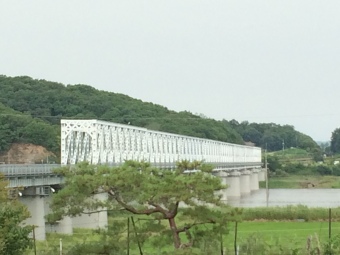
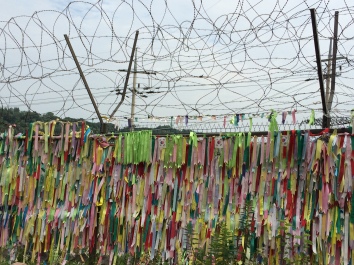
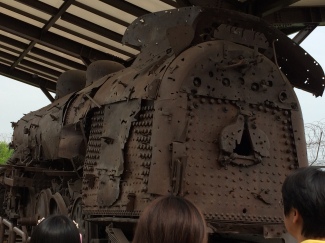
The second stop was to the Third Infiltration Tunnel. A North Korean defector civil engineer told the South Koreans that North Korea had built tunnels past the DMZ to infiltrate South Korea one day. Since then, South Korea has been working to uncover the location of all of the tunnels. They have found four so far and estimate that there may be over twenty. The third one was discovered in 1978 and is the biggest of the four. It is 1.7km long (~1 mile) and 1/3 of it extends into South Korea. The third tunnel can allow 30,000 soldiers to invade in one hour. When confronted, North Korea said that they built the tunnel to coal mine and dusted the walls in charcoal to complete their alibi. You could see the spots where sticks of dynamite had been placed to allow expansion. We could only go up to the third blockade (~300 meters in) and only militia could go past the next two blockades towards the border line. They made a window so we could peek deeper in and this tunnel was drearier past all of the blockades. No photos were allowed, unfortunately.
Prior to going in, we watched a short documentary on the history of Korean attacks and the last major one went up to 2010. I know we are only hearing one side, but I felt like North Korea is perpetually attacking South Korea in hopes of capturing the country. The movie we watched for class documented a naval attack in 2002. In the 2000’s, the Koreas signed a peace agreement to allow tourists to pass between the countries but that was broken in 2008 when North Korean military men shot a South Korean woman for supposedly going to a restricted area. Also, I didn’t realize that the major players in this war were China, Russia, and N. Korea vs. S. Korea and the US. We had our own war memorial in Imjingak and another tribute closer to the border where N. Koreans axed our army men to death for chopping down a tree on our side.
The third stop was the Dora observatory were you could see the Southern Limit Line, the DMZ zone, and North Korea. The SLL was marked with a long barbed wire fence. The DMZ is a neutral zone and only wildlife and a free ecosystem exists here. Then N. Korea was a mountainous, tree-less clearing. There was one visible city, but the tour guide said it was propaganda to attract people over for a “better life”. At the North and South limit lines, you could see both countries’ flags facing each other. The last stop was to the Dorasan train station which can no longer run north to connect with the Eurasia train system.
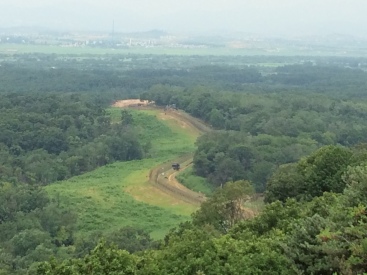
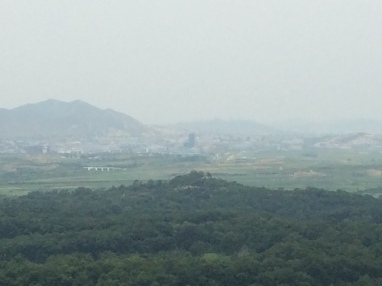
The tour was a lot sadder than anticipated. War is awful for everyone, but I’ve never thought about individual lives and how it affects actual people. I think we learn about it as country versus country and casualties are just a number. Everyone in a war is forced to do something that they don’t want to do – despite knowing the risks when signing up for the military. But the honor for their country and hope of freedom for their families’ future generations outweighs their own lives. Around 30-40% of Korean men have PTSD after their 2 year service. I can’t even imagine having to constantly think about the past, and wondering if it was better to have had just died fighting than to remember seeing your friends suffer and die every day. I was excited to go to the DMZ to look “the enemy” in the eye, but across on those mountains, someone is wishing for peace. Korea was one country until 1945 so there are generations that are still alive or whose parents lived in a whole Korea. Families still live in separation. The separation into two countries wasn’t even Korean people’s decision, but a decision amongst competing US and Soviet powers. While neither country owns any part of the Koreas, their mark lasts and perpetuates animosity between the two.